Free Email Open Rate Calculator
Are your subscribers opening your email campaigns and newsletters? Use our free email open rate calculator to find your open rate now!
Try it now ➔
What is an email open rate?
Email open rate is the frequency at which subscribers open the emails you send to their inboxes. You can find your email open rate with the following equation:
Email opens / total emails sent = email open rate
Email open rate along with email click rate gives you insight into how often and how much subscribers engage with your email campaigns or newsletters. Open rate describes how often users open email content, while clicks represent how often they click links within the opened message.
What is a good email open rate?
According to Mailchimp analytics from 2022, the average email open rate across all industries was around 21.33%. This applies to both average open rates for newsletters and open rates for email campaigns.
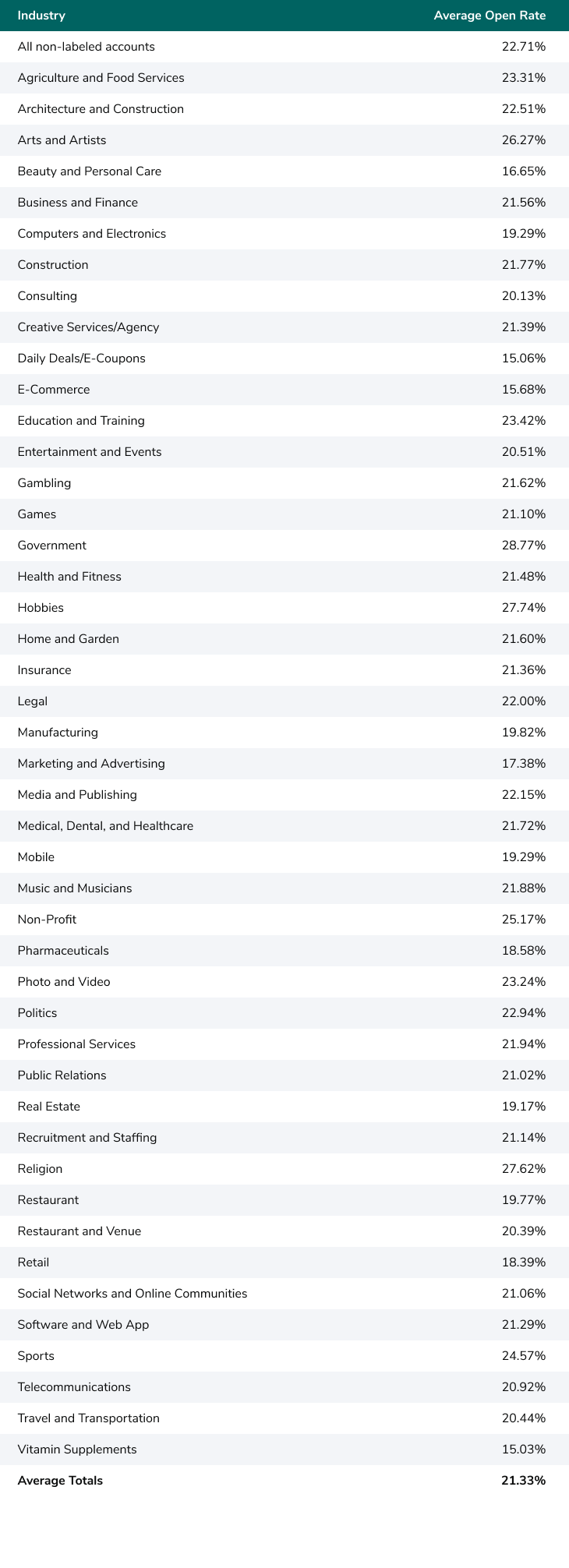
Industry standard email open rate - source: MailChimp
However, open rates can vary greatly depending on the type of product or service you’re selling or depending on the content therein.
Sensitive or highly-personal emails typically fair the best. For example, they found that government correspondence demonstrates some of the best email open rates, followed closely by newsletters focusing on personal interests and hobbies. Meanwhile, sales-oriented businesses in retail, software or food typically show open rates of 21% or lower.
It’s worth comparing to a January Constant Contact study that their email open rates trend higher during particular months. Steady trends in open and click-to-open rates align with statistics estimating that email marketing will cross the $10 billion threshold in 2023, making email one of, if not the best channel for a positive return on investment (ROI).
How our email open rate calculator works
Our email open rate calculator lets you quickly calculate your email open rate by comparing your number of sent messages versus the number of opens. Your email service provider (ESP) will provide these numbers in any of your campaign overviews.
To use the calculator, follow these steps:
1.Enter the number of emails sent in your campaign. Ideally, this should be the total number of contacts on your targeted email list.
However, pay close attention to your bounce rate to determine if any messages went undelivered. A user cannot open your email if they don’t receive it.
Your ESP should provide these numbers in your campaign summary and look like this:
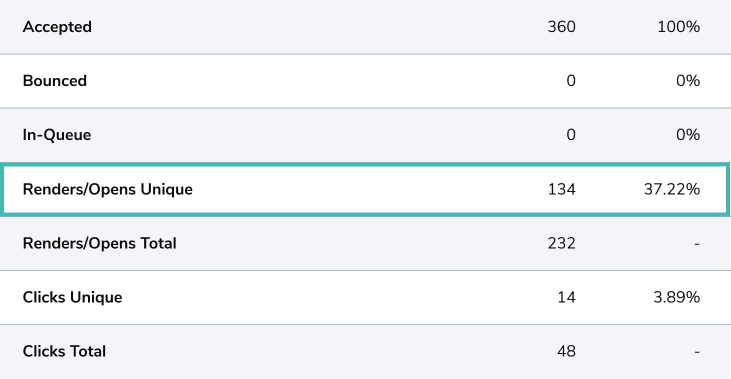
Be sure to count unique opens, not total opens, to avoid counting repeat readers.
In this example, this campaign has a 100% delivery rate, meaning 360 messages were sent. Enter your number of sent messages in the first field.
2.Then, enter the total number of email opens from the campaign. If your ESP is like the example above, you want to enter the number of unique opens. Your total opens refers to individual readers and users that opened your email more than once.
3. Click Calculate.
Reading your email open rate results
After the calculation completes, you’ll find your email open rate listed below the tool.
In addition to your open rate percentage, we’ll let you know whether or not your current open rate is ideal with the following text:
- “Your email open rate is good.”
- “Your open rate is below average, and there could be issues with your email list.”
Based on industry averages, anything above 20% is a good open rate for email. Conversely, anything below a 20% email open rate is problematic.
Let’s look at what might cause poor performance regarding email open rates.
What causes poor email open rates?
If your email open rate is below 20%, the cause could be any one or more of the following factors.
Uninteresting subject lines
47% of email users choose to open or ignore an email based on just the subject line.
This is particularly true for active email users that receive hundreds of emails per week. These individuals need to sort critical communications from overly-promotional fluff quickly and are likely to skip over anything that doesn’t stand out.
Ensure your subject line is short, engaging and directly communicates the point.
Inconsistent email content
Inconsistency can stall your email marketing metrics. This applies to both your sending frequency and the quality of the content within the email.
People love predictable patterns. That’s why you should select a regular sending schedule based on the time your subscribers seem most active. If you suddenly stop sending exciting content, your subscribers will likely forget about you. On the other hand, sending too many unnecessary emails might cause users to mark you as spam.
Consistency also applies to email quality. If you notice that your open rates are declining, users may not find what you’re sending particularly interesting. Be sure to proof your email content with your team, and check in with your audience about what they’d like to see from your newsletter.
Issues with preheader text
Preheaders, also known as preview text, are the line of text that immediately follows an email subject line.

Preheaders are a great way to sell the value of your email content.
Preheader text can be an incredible tool in your email marketing arsenal when used correctly. Like the subject line, it can help communicate the contents of the email and why the reader should open it. You can elaborate further on what’s inside, stoke a sense of urgency or highlight an important detail they learn more about inside.
If you don’t optimize your preheader, it typically auto-fills with content from the email body. This can look messy, unpolished or even spammy if there are additional issues to be found within the email.
Learn how to optimize your preheader text properly to help improve your email open rates.
Undelivered emails
Though this technically doesn’t count against your current open rate, bounced messages can be a critical factor. If subscribers aren’t receiving your emails, they can’t open them.
If you see a sudden drop in email opens, take a look at your bounce rate. Issues with content, your SMTP configuration, or other email deliverabilityⓘA sender’s ability to reach the recipient’s inbox with their outgoing emails. It may also describe the ratio of emails delivered to the inbox vs. those sent to spam or blocked by the receiving server. issues may prevent your content from reaching readers that would otherwise open those emails.
How to track open rate for email marketing
You can always track your email open rate by checking in with your ESP. If you use email services like Mailchimp or SendGrid, you can review email open rate by campaign or newsletter.

Mailchimp highlights successful deliveries, opens and forwards for each campaign.
The general campaign overview should provide important statistics like opens and clicks. However, viewing your report can gain even deeper insights into when and how often users engage with your emails.
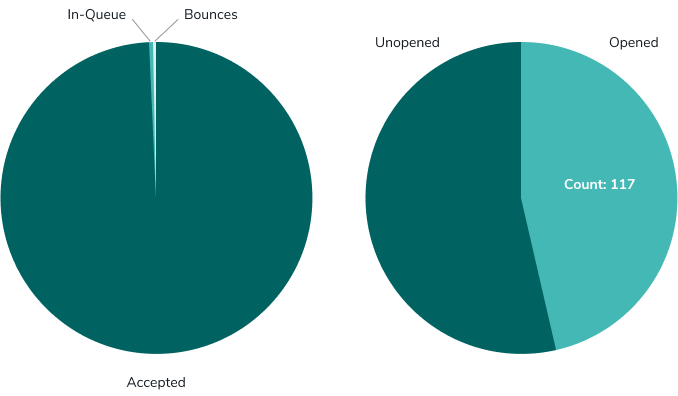
Check your ESP to review your email campaign and newsletter open rates.
When in doubt, remember this formula:
Email opens / total emails sent = email open rate
How to use email open rate to improve email campaign and newsletter open rates
By tracking email marketing open rate, you can use the data to guide the creation of future newsletters and email campaigns.
Review the average open rates for email marketing above. If your brand consistently meets or exceeds the average, keep up with your current strategy. Your audience engages with your emails and converts on the schedule we expect from typical email marketing. However, there’s always room for improvement!
On the other hand, falling below your industry average is a sign that you need to implement changes to boost your email campaign open rates.
Tip 1 - Segment your email lists
Sending out a generalized email message to a mass audience simply doesn’t cut it any longer if you want better-than-average open rates for email campaigns.
Audiences look for a personalized experience from the account sign in screen to their email inbox. Taking your entire email list audience and segmenting it into carefully-targeted lists can help you curate the perfect message for each group.
A Mailchimp study suggests that curating the message to a person’s demographics or specific interests can boost the average email campaign open rate by more than 14%.
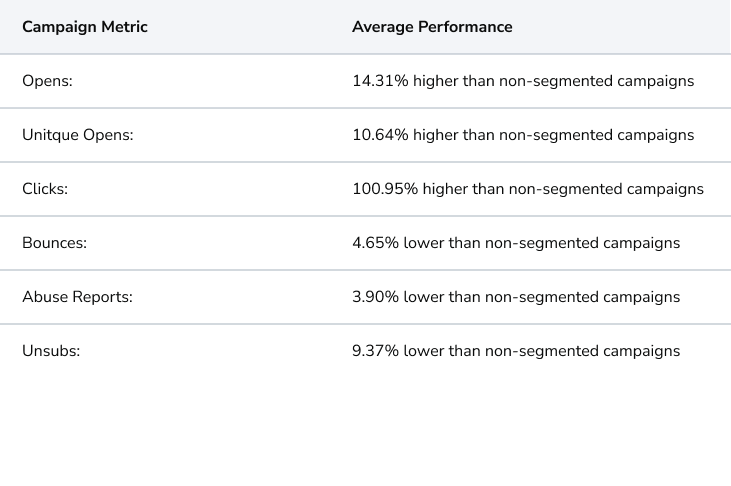
Mailchimp breaks down exactly how much list segmentation boosts open rates for email marketing.
Though your product or service might benefit a broad audience, not every subscriber has the same background, interests, income or occupation. Finding the most optimal ways to segment your audience into groups affords your marketing team more useful data when creating email subject lines, messaging and offers that convert.
Tip 2 - Make it personal to boost your newsletter open rate
People receive hundreds of marketing emails weekly and monthly. Let’s face it - neither you nor I want to waste much time wading through boring content designed to reach the most people.
What does work, however, is a message that’s friendly, personal, and deviates from what you’d expect from the average business. Let’s look at an example:
“Hi &&first_name&&
It's Brian Minick from ZeroBounce. Thanks for joining us for the GetResponse webinar!
Invalid or risky email addresses can impact any brand...
It just takes one spam trap or a few too many bounces to hurt your sender reputation.
I want to make finding the inbox easy.
Try out the ZeroBounce email validator now - with 1,000 free credits.
Just hit Reply!
I'd love to hear feedback about your experience and any questions you have about the topics we covered.
Thanks again for joining me!”
Brian Minick
This follow-up to a Thursday afternoon webinar received nearly a 50% open rate. But what exactly made this email work?
- It greets the person by name
- It’s directly from the person they’re familiar with
- It’s respectful of the reader’s time
- It summarizes what they remember from the webinar
- It pays the reader for their time with a great promo
- It invites the reader to share and be part of the experience
It pays to know who you’re speaking to deliver a relaxed, personalized email. Subscribers respond better when you make an honest effort to connect with the community.
Tip 3 - Subject lines and preheaders are vital in boosting email open rate
It’s commonly said the average human attention span is now less than a goldfish. While this particular statistic seems untrue, what is true is that humans will not spend time on something that does not feel relevant or meaningful.
Your audience is busy. They commute to work, attend meetings, fulfill their duties and sort through hundreds of emails and SMS messages regularly. Unless you make it so, just another marketing email isn’t meaningful or relevant.

Chase provides a straight-to-the-point subject line and preheader that encourages you to read more.
To boost your email campaign open rate, spend time crafting subject lines and preheaders that make an effort to reach out to the individual. What is it about your email that’s particularly important or worthwhile? Distill that answer into a sharp, clean subject line that tells the reader.
The body of the content is essential but ultimately means little if you can’t get subscribers to open the email.
Tip 4 - Use email validation to increase your marketing email open rates
Finally, always keep your email lists clean to avoid unnecessary bounces. This process ensures that your emails can reach your entire subscriber list and allow them to open your messages.
Email validation quickly identifies valid addresses and segregates them from invalid or high-risk email addresses on your list. Invalid addresses lead to hard bouncesⓘThe inability to deliver an email message that’s caused by one or more permanent factors, such as an invalid email address., while risky emails like catch-alls, bot-generated emails and spam traps go unread and hurt your email deliverability.
When messages go unread, your email reputationⓘAlso referred to as ‘Sender Reputation.’ This describes how trustworthy a sender is when sending emails. Reputation is influenced by past campaign performance and sending habits, including bounce rate, spam complaints, abuse reports, email authentication, sending volume, and domain history. suffers, and even more of your messages might never reach the inbox. However, they still might reach the spam folder and report back as “delivered,” adding to your poor open rate.
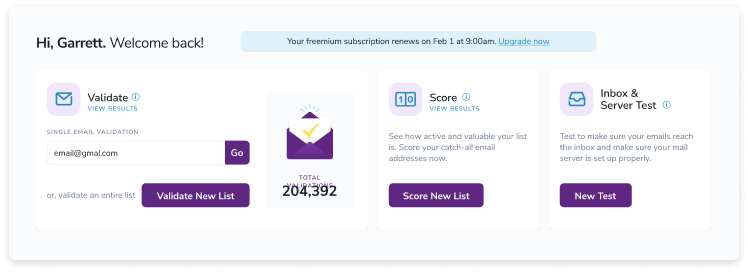
The new ZeroBounce platform allows you to upload more emails faster for validation. Clean your list for a better email open rate.
Email validation with ZeroBounce is quick, trustworthy and affordable. Create a free account today, get 100 free validation credits and start verifying the addresses on your list to boost your email open rate.
Validate My Emails for a Better Open Rate
Try these free email deliverability calculators
Frequently asked questions about email open rate
The average email open rate across all industries is 21%. Some industries like art and hobbies reach above 25%, while industries like pharmaceuticals are regularly below 20%.
Low email open rates can occur for various reasons, including:
• Poor email list health
• Inconsistent sending schedule
• Low-quality content
• Boring, vague subject lines
Yes. Sending emails and using an email service provider costs money. Email marketing is of little value if subscribers do not open your messages.
Additionally, low email open rates hurt your email sender reputation. Other email servers may see your content as suspicious or untrustworthy if you continuously demonstrate low open rates. When this happens, they may block your emails or relegate them to the spam folder, making email marketing even less effective.
Email open rate is the number of emails opened divided by the number of emails successfully delivered.
While not entirely accurate, checking your email open rate with your ESP is a great way to track your marketing performance. Certain factors, such as spam filters, privacy settings and message size can affect deliverability and inbox placement.
It’s essential to watch for noticeable shifts in trends to determine if there’s an issue with your email content. Be sure to track open rates with other valuable metrics like clicks and click-to-open rates to understand your performance better.
You can make noticeable improvements to your email open rate with some of these tactics:
• Validate your email list to improve email hygiene
• Remove unengaged subscribers
• Keep a consistent sending schedule
• Segment your email lists
• Keep up with the quality
• Make it friendly and personal
